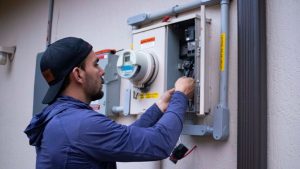Your home is your place of safety or refuge. However, significant repairs such as a crumbling foundation, a damaged roof, or a failing HVAC system can undoubtedly feel like a financial hill to climb, requiring more than everyday budgeting. The good news is that many funding solutions can help tackle them. Here are some of them.

Personal Loans
Personal loans provide quick access to funds without being secured against your home. You can find these loans through online platforms, credit unions, and traditional banks, each providing distinct ways to satisfy your needs.
Online personal loans are known for being accessible and convenient. Loan amounts typically range from $300 to $5,000, depending on the lender, making them a practical choice for smaller, urgent repairs like fixing storm-damaged siding. They’re also available to homeowners with less-than-perfect credit, with some lenders, such as CreditNinja, offering options for a wider range of credit situations. Funds are usually disbursed within a few hours, helping you handle repairs without long delays.
On the other hand, credit unions offer personal loans with a member-focused approach. Members can submit personalized applications that consider their financial history. Finally, you can choose to apply online or head to a nearby branch if working with a traditional bank. You’ll work with a loan officer to inquire into loan amounts, ranging from $1,000 to $100,000, based on your income and credit.
To begin applying with an online lender, credit union, or bank, collect key documents like identification and recent pay stubs. Next, reach out to a loan officer to review available repayment terms and loan amounts.
Savings
When home repairs aren’t urgent or high-priority, saving up can be an excellent way to fund big-budget projects. You can start by establishing a monthly savings goal, say $250, and put it into a high-yielding savings account. Doing so will keep your money accessible and growing.
Get a rough figure or quote for your repair to keep track of your expenses. According to Forbes, a full roof replacement for an average-sized home can cost up to $11,500, while new windows could cost $1,400 per window. Then, divide the estimate by your timetable, like 36 months, to compute how much you should save each month.
To ensure you can reach the goal, consider making minor budget tweaks, such as discontinuing a streaming service or skipping some coffee runs. Automating transfers is also an excellent way to avoid missing out on savings.
This funding option is best suited for planned, targeted repairs where you have enough time to strategize. It keeps your home in peak condition and your finances stress-free.
Home Equity Line of Credit (HELOC)
A HELOC cashes in on your home’s equity, offering a great way to fund costly home repairs. It is a reusable credit line, allowing you to borrow as needed for major home projects like a roof overhaul or a foundation repair. Additionally, it’s perfect for costs that spread over time or phased repairs.
The process of getting a HELOC warrants a home appraisal to verify value. Lenders then provide calculators to gauge your borrowing limit. Suppose your property is valued at $300,000 and you owe $100,000 on your mortgage; you can access a portion of that $200,000 equity.
Community or Government Home Repair Assistance
Community and government programs offer vital support for homeowners dealing with costly repairs. These initiatives help cover urgent improvements that keep homes safe, livable, and structurally sound.
Here are some programs you need to know:
- Weatherization Assistance Program (WAP). This program provides funding repair assistance to low-income households to improve energy efficiency—for example, furnace upgrades or window replacement to cut down utility costs.
- Local Housing Agencies. Many counties and cities operate programs through housing departments, providing low-cost loans or grants for emergency home repairs or energy efficiency. These programs usually target disabled residents, seniors, or low-income families.
- Section 504 Home Repair Program. This program grants up to $10,000 and loans up to $40,000 to impoverished rural homeowners. It’s perfect for home projects like plumbing upgrades or HVAC replacements.
- USDA Single Family Housing Repair Grants. This program offers grants of up to $10,000 to address health and safety hazards, such as roof patches or electrical system overhauls. It’s intended for rural homeowners aged 62 and older.
- HUD Title 1 Property Improvement Loan. This program provides up to $25,000 for single-family households and homeowners with irregular income levels. It focuses on vital improvements that enhance livability and safety, such as ramp installation or foundation reinforcement.
- Nonprofit Organizations. Groups like Habitat for Humanity or Rebuilding Together offer subsidized or free repairs, especially for low-income households, seniors, or veterans. They may cover structural repair or insulation projects, anything that focuses on community impact.
So, how to apply? Start by visiting USAGov’s home repair page or contacting your county housing department, community action agency, or local HUD office. Typically, you must submit proof of income, homeownership documents, and repair details. A home inspection may be necessary to assess urgent needs.
Contractor Financing
Many home contractors offer payment plans to make expensive repairs easier to manage. These plans let you spread the cost over time and are available through the contractor or their partner lenders. This way, you can start the repair without paying the full amount upfront.
If you’re getting a $25,000 roof repair, a contractor might offer a payment plan with monthly installments over 12 or 24 months. Some may even give you a promotional period with no payments for a while, making it easier to manage your budget.
To make the most of this option, bring up financing when collecting quotes from contractors. Ask about repayment plans, program details, and whether services like warranties are included. Many remodeling, HVAC, and roofing professionals offer straightforward financing options—making it easier to fund major projects like a $25,000 siding upgrade or an $18,000 bathroom renovation.
Choosing the Right Option
Big-budget home repairs don’t have to be distressing. Different options cover these fixes, from personal loans to contractor financing. Each path helps you address and settle pressing fixes and dedicate funds to your home’s future. Contact an online lender, contractor, government resource, or bank today to start your application. Remember that your home deserves the best and these options make it happen.








